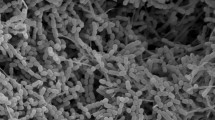Summary
Eight species ofCephalosporium from man are revised, mostly on original strains.Cryptomyces pleomorpha Gruner is a typicalCephalosporium acremonium; in additionCryptomyces is a valid Phacidiaceous genus described more than a century ago. Of two human strains of the same species, one has been fully pathogenic for laboratory animals.
Allantospora violacea Ambr.,A. onychophila Vuill. and an unnamed strain were revised. All are to be referred toCephalosporium (Allantospora)onychophilum (Vuill.) Coudert.
Two strains ofAcremonium kiliense are typicalC. acremonium. C. serrae Maffei is a good species, but probably indistinguishable from the saprophyticC. subverticillatum Schulz et Sacc., reisolated in Italy in the year 1934.
C. spinosum Negroni — probably indistinguishable fromC. cordoniformis Barbosa, both South American species — is a coremioidal form ofC. acremonium.
C. rubrobrunneum (?) Benedek is a simpleC. acremonium, as well asC. stuehmeri Schmidt et van Beyma.
In addition to the previously named species,C. pseudofermentatum Cif. (if really possess a yeast-like stage) andC. nigrum Kamb. (if this species is pertaining to the genusCephalosporium) are listed.
Similar content being viewed by others
Letterature citata
Alcock, N. L. (1926) Successional diseases in plants as shown in Willow rods. Brit. Mycol. Soc. Trans.,XI, 161–167.
Ambrosioni, P. (1938)Allantospora violacea n. sp. ritrovata in un caso di erosione interdigitale. Riv. di Parassit.,II (2), 151–158.
Aschieri, E. (1932) Ricerche sistematiche e fisiologiche su unHyalopus causa di onicomicosi. Atti R. Ist. Bot. Univ. Pavia, ser. 4,III, 45–65.
Barbosa, F. A. S. (1941) Subsidios para o estudo parasitologico do generoHyalopus Corda, 1830. 62 pag., 6 tav. Recife.
Benedek, T. (1928) Vergleichende Untersuchungen über einige Arten der GattungCephalosporium nebst Mitteilungen einer neuen Art:Cephalosporium niveolanosum nov. spec. Arch. Dermat. Syphil.,CLIV, 154–167.
Benedek, T. (1929) Ist dasCephalosporium asteroides griseum Gruetzii (Grütz 1925) Benedek emend. 1927 mit demCephalosporium Acremonium Corda 1839 identisch? Dermat. Wochenschr.,LXXXVIII, 892–897.
Benedek, T. 1928 Über Cephalosporiose. Ein Beitrag zur Kenntniss der seltenen Mykosen unter besonderer Berücksichtigung der Serumdiagnose. Arch. f. Dermat.,CLIX, 96.
Beyma thoe Kingma van, F. H. (1940) Über einige Formen vonVerticillium dahliae Klebahn. Ant. van Leeuwenhoek,VI, 34–47.
Buchanan (1911) Morphology of the genusCephalosporium, with description of a new species and a variety. Mycologia,III, 170
Ciferri, R. (1932)Cephalosporium pseudofermentum n. sp. isolato dalla bocca dell'uomo. Arch. f. Protistenk.,LXXVIII, 227–237.
Courtelen, F., Cochet, G. etBiguet, J. (1948) Les céphalosporioses humaines. Revue critique à propos d'un cas. Ann. Parassit. Human. Comp.,XXIII, 364–398.
Dodge, C. W. Medical Mycology. St. Louis.
Greville, R. K. (1826) Scott. Crypt. Fl.,IV, 206.
Gruetz (1925) Beitrag zu den seltenen Mykosen: über eine durch Akremonium verursachte Pilzerkrankung. Dermat. Wochenschr.,LXXX, 765.
Gruetz (1928) Bemerkungen zu Benedeks Arbeit. Arch. f. Dermat.,CLVI, 237.
Gruner, O. C. (1935)Cryptomyces pleomorpha: a new organism isolated from the blood of a case of metastasized carcinoma of the breast. The Canad. Med. Ass. Journ.,XXXII, 15–19.
Hartmann, E. (1926) Über ein gemeinsames Vorkommen vonCephalosporium undTrichophyton gypseum. Dermat. Wochenschr.,LXXXII, 565–569.
Kambayashi, T. (1937) Botanische Untersuchungen über japanische Fadenpilze, die auf der Menschenhaut parasitieren. III Mitteil. ÜberCephalosporium nigrum isoliert von einer Dermatomycosis in Aethiopien. Bot. Magaz. (Tokyo),LI, 436.
Kroemer, G. (1936) Über die bisher bekannten menschlichenCephalosporium infektionen; nebst Undersuchungen über zwei verschiedene Stàmme vonCephalosporium acremonium Corda. Zeitschr. f. Parasitenk.,VIII, 317.
Luchetti, G. (1934) Sulla biologia delCephalosporium subverticillatum Schultz et Saccardo. Boll. R. Ist. Sup. Agr. Pisa,X, 77–82.
Luchetti, G. (1937) A propos des particulières propriétés borophiles d'unCephalosporium. Boll. Sez. Ital. Soc. Intern. Microb.,IX, 162–165.
Luchetti, G. (1939) Sulla biologia delCephalosporium acremonium Cda. Ann. Fac. Agr. R. Univ. Pisa, N.S.,II, 1–27.
Maffei, O. L. (1928) Nuova specie diCephalosporium causa di una cheratomicosi dell'occhio. Atti Ist. Bot. R. Univ. Pavia, ser. 4,I, 183–198.
Nannizzi, A. (1934) Repertorio dei miceti patogeni dell'uomo e degli animali. Siena.
Negroni, P. (1933) Onychomycose parCephalosporium spinosum n. sp. C. R. Soc. Biol.,CXIII, 478–480.
Negroni, P. (1933) Onicomicoses porCephalosporium spinosum. Rev. Soc. Argent. Biol.,IX, 16–22.
Petch, B. A. (1925) Studies in Entomogenous Fungi. VI:Cephalosporium and associated fungi. Trans. Brit. Mycol. Soc.,X, 152–182.
Pinkerton, M. E. (1936) A comparative study of conidial formation inCephalosporium and some related Hyphomycetes. Ann. Miss. Bot. Gard.,XXIII, 1–55.
Rehm, H. (1888) in Rabenhorst, Krypt.-Fl. Deutschl., Abth. 1,III, 106.
Richon (1892) Notice sur leCephalosporium dutertri n. sp. Bull. Soc. Mycol. France,VIII, 60–62.
Serra, G. M. (1929) Un caso di cheratomicosi da un micete non isolato finora dall'occhio. Osservazione clinica, studio batteriologico ed istopatologico. L'Aten. Parmense,I, 549–580.
Verona, O. (1932) IlCephalosporium subverticillatum Schultz et Sacc. quale idrocarburofilo. Nuovo Giorn. Bot. Ital., N. S.,XXXIX, 674–677.
Vuillemin, P. (1912) Sur une nouvelle espèce deTilachlidium et les affinités de ce genre. Bull. Soc. Myc. France,XXVIII, 113–120.
Vuillemin, P. (1931) Les champignons et les mycoses de l'homme (pag. 63). Paris.
Author information
Authors and Affiliations
Additional information
Queste note furono redatte in gran parte tra il 1938 e il 1939; poi, per varie ragioni, rimasero inedite. Le ripubblichiamo con dati bibliografici aggiornati ed un maggiore materiale critico, anche in omaggio al comune amico, il compianto Prof.P. Redaelli.
Rights and permissions
About this article
Cite this article
Ciferri, R., Redaelli, P. & Giordano, A. Revisione di alcuniCephalosporium isolati da casi patologici umani. Mycopathologia et Mycologia Applicata 8, 169–182 (1957). https://doi.org/10.1007/BF02052829
Issue Date:
DOI: https://doi.org/10.1007/BF02052829




